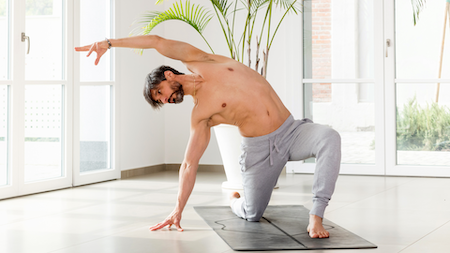The Five Best Yoga Poses For Endurance Athletes

Endurance athletes often push their bodies to their limits. Are you an endurance athlete looking to take your performance to the next level? You should consider adding yoga to your training regimen. Yoga is a full-body workout that can help to improve flexibility, strength, balance, and mental clarity. This makes it the perfect complement to endurance training.
Here, we will explore the five best yoga poses for endurance athletes and how they can help you achieve your goals. These yoga poses are sure to impact your endurance and overall performance positively. So, let’s start the journey to a stronger and more balanced you!
The Best Yoga Poses for Endurance Athletes
Downward Dog (Adho Mukha Svanasana)
Downward-Facing Dog is an inversion posture that is commonly practised in yoga. It is performed by starting on all fours and then lifting the hips while straightening the arms and legs. This forms an inverted V-shape with the body. The pose is held for several breaths and can be repeated several times.
This pose improves flexibility and endurance by stretching the hamstrings, calves, and spine. It also strengthens the legs and back by engaging the legs, glutes, and back muscles. The back stretch can help alleviate tension and reduce the risk of injury.
Warrior II ((Virabhadrasana II)
Warrior II is a standing yoga pose where one leg is in front, and the other leg is in a lunge position with the back leg straight. The arms are extended to the sides, creating a T shape with the body. The pose strengthens the legs, hips, and core while stretching the chest, hips, and legs.
Warrior II improves balance and stability by engaging multiple muscle groups and forcing you to maintain proper alignment and balance. This makes it essential for endurance athletes, as it helps to prevent injury and improve overall performance. Additionally, the pose improves flexibility, enhancing the range of motion and avoiding damage during endurance activities.
Pigeon Pose (Eka Pada Rajakapotasana)
Pigeon Pose is a hip-opening yoga pose that stretches the hip flexors, glutes, and lower back. The pose is performed by starting in a plank position, bringing one knee forward to the opposite elbow, and straightening the other leg behind you.
Pigeon Pose improves hip flexibility by stretching the hip flexors, glutes, and lower back, which can help to reduce tightness and improve the range of motion. This helps to improve overall performance by reducing tightness and enhancing the range of motion in the hips and lower back. The pose can also help to increase circulation and release tension in the hips, which reduces fatigue during endurance activities.
Tree Pose (Vrksasana)
Tree Pose is a standing yoga pose. Here, you balance on one foot while the other foot goes on the inside of the opposite thigh. The arms are usually raised above the head, and the gaze is focused forward.
Tree Pose improves balance and stability by requiring you to balance on one foot and engage multiple muscle groups. This makes it essential for endurance athletes, as it enhances performance by increasing balance and stability. The pose can also improve your running form and efficiency, helping you perform at your best for extended periods.
Triangle Pose (Trikonasana)
Triangle Pose is a standing yoga pose where one leg is forward, and the other is back, creating a wide stance. The pose strengthens the legs, hips, and spine while stretching the hamstrings, hips, and spine.
Triangle Pose positively impacts endurance by improving flexibility and strength in the legs, hips, and spine. It promotes recovery, relieves stress, and improves flexibility. In fact, the forward bend in the pose can help to ease tension and stress in the back and neck, and the wide stance can help to open up the hips and relieve tension in the legs.
Overall Benefits of Yoga to Endurance Athletes
The practice of yoga can bring numerous benefits to endurance athletes, including:
- Flexibility: Yoga poses help to increase flexibility and range of motion. This helps to reduce the risk of injury and boost performance.
- Balance and stability: they improve thanks to yoga. It is important for endurance athletes who must maintain these qualities for extended periods.
- Strengthen: Several yoga poses can help to strengthen vital body parts. They include the legs, hips, and core, which are necessary for endurance activities.
- Better breathing: Yoga places a strong emphasis on controlled breathing. This helps increase endurance and oxygenation during physical activity.
- Reduced stress: Yoga can help to reduce stress and improve mental clarity. Reducing stress is especially useful for endurance athletes who require long mental focus and discipline periods.
- Better recovery: Yoga also promotes healing and reduces muscle soreness. So endurance athletes can bounce back quickly from intense training sessions.
Takeaway
Yoga is a versatile and valuable tool for endurance athletes looking to improve their performance and reduce the risk of injury. So, if you’re an endurance athlete looking to enhance your performance and reduce your risk of injury, consider adding yoga to your training routine today.


Leave a Reply
You must be logged in to post a comment.